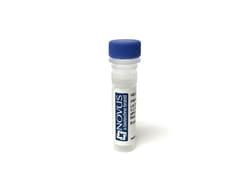CD43/Sialophorin Antibody (Bra7G) - IHC-Prediluted, Novus Biologicals™
Manufacturer: Novus Biologicals
Select a Size
| Pack Size | SKU | Availability | Price |
|---|---|---|---|
| Each of 1 | NBP248393-Each-of-1 | In Stock | ₹ 45,078.50 |
NBP248393 - Each of 1
In Stock
Quantity
1
Base Price: ₹ 45,078.50
GST (18%): ₹ 8,114.13
Total Price: ₹ 53,192.63
Antigen
CD43/Sialophorin
Classification
Monoclonal
Conjugate
Unconjugated
Formulation
10mM PBS and 0.05% BSA with 0.05% Sodium Azide
Gene Symbols
SPN
Immunogen
Immature pluripotent human leukemia K562 cells
Quantity
7 mL
Research Discipline
B Cell Development and Differentiation Markers, Immunology
Gene ID (Entrez)
6693
Target Species
Human
Form
Purified
Applications
Immunohistochemistry, Immunohistochemistry (Paraffin)
Clone
Bra7G
Dilution
Immunohistochemistry, Immunohistochemistry-Paraffin
Gene Alias
CD43 antigen, CD43), Galactoglycoprotein, GALGP, Leukocyte sialoglycoprotein, Sialophorin, sialophorin (gpL115, leukosialin, CD43)
Host Species
Mouse
Purification Method
PEG purified
Regulatory Status
RUO
Primary or Secondary
Primary
Test Specificity
It recognizes a cell surface glycoprotein of 95/115/135kDa (depending upon the extent of glycosylation), identified as CD43 (Workshop V). Epitope of monoclonal antibody Bra7G is clearly different from that of monoclonal antibody DF-T1, called b as opposed to a for DF-T1. 70-90% of T-cell lymphomas and from 22-37% of B-cell lymphomas express CD43. No reactivity has been observed with reactive B-cells. So a B-lineage population that co-expresses CD43 is highly likely to be a malignant lymphoma, especially a low-grade lymphoma, rather than a reactive B-cell population. When CD43 antibody is used in combination with anti-CD20, effective immunophenotyping of the lymphomas in formalin-fixed tissues can be obtained. Co-staining of a lymphoid infiltrate with anti-CD20 and anti-CD43 argues against a reactive process and favors a diagnosis of lymphoma.
Content And Storage
Store at 4C.
Isotype
IgM κ
Related Products
Description
- CD43/Sialophorin Monoclonal specifically detects CD43/Sialophorin in Human samples
- It is validated for Immunohistochemistry, Immunohistochemistry-Paraffin.
